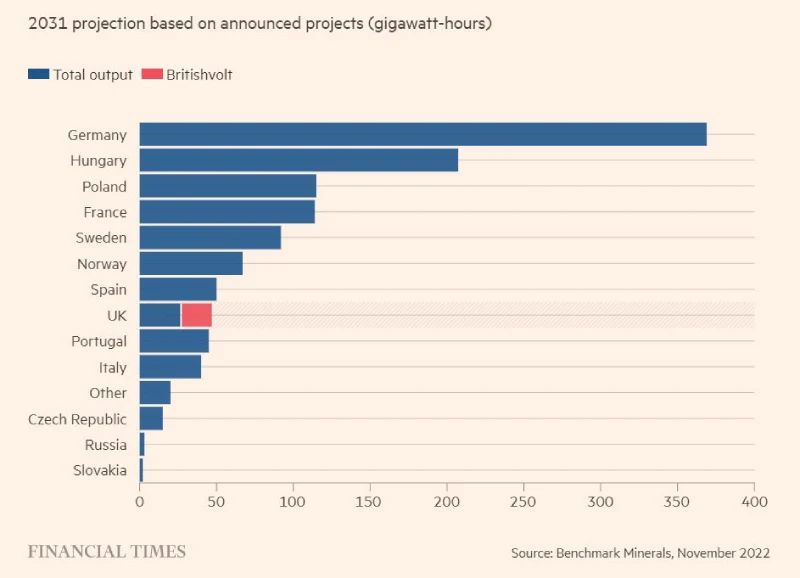Britishvolt: The UK falls behind again
Valued at £3.8 billion pounds at its peak, Britishvolt was until recently one of Britain’s most renowned up-and-coming projects. The battery gigafactory in Blyth would provide 3,000 skilled jobs and provide the batteries needed for Britain’s electrification.
Instead, Britishvolt crashlanded into administration, as the media gradually uncovered the smoke and mirrors surrounding the endeavour. This article briefly explores what happened and the consequences for everyone in the UK.
TL;DR: it’s not good.
⚠️ Update (April 2024): US equity firm purchases BritishVolt site for £110m to build one of Europe’s largest data centres, re-igniting hopes for the Northumberland town. More details here.
Contents
- The promise
- A brief history of Britishvolt
- Why did Britishvolt collapse?
- What are the knock-on effects?
- Conclusion
- 2024 update
The promise

All the hype and expectation around Britishvolt was about delivering its initial 30GWh Li-Ion battery factory that would cover an area the size of 50 football pitches at the former coal store of Blyth coal power station.
The site was named ‘Cambois’ and is regarded as ideal for a battery factory, having:
- Access to Dogger Bank’s and other wind energy projects’ green electricity is essential for being as low-carbon as possible.
- Direct rail access to the deep water port of Blyth for the import/export of materials/batteries.
- Having a pre-existing connection to the national grid.
Brexiteers marketed the plant as one of independent Britain’s flagship projects. It helped the Conservative government win local elections in 2019 despite this constituency being a traditional Labour area or ‘red wall’.
And more factually, having a national battery production is a necessity to keep the UK up-to-date with the global trends of decarbonisation, meet its own climate commitments, and support its local car manufacturing businesses.
Let’s take a step-by-step look at how Britishvolt collapsed:
A brief history of Britishvolt
Britishvolt was incorporated in December 2019. A year later, Cambois was selected as the ideal location for the Gigafactory.

The hype was real; investors included Fortune 500 companies like Swiss mining giant Glencore.
Construction began in September 2021, and in January 2022, the UK government committed £100 million through the Automotive Transformation Fund.
The hype continued, and other renowned investors flocked into the venture in 2022. Among them are NG Bailey, Ashtead Group, Abrdn, Bank of America, and Citibank, who valued the company at over £1 billion based on the promise of its gigafactory success.
In August 2022, CEO Orral Najiri was ousted, and soon after, the company’s smoke and mirrors began crumbling.
An article by The Guardian revealed prolific spending on ostentatious endeavours, including hospitality suites, luxury cars, and private jet flights, despite the company’s lack of earnings.
Another piece by The FT revealed that spending reached £3 million per month on wages for its 300 staff while it was years away from generating any income, and hundreds of millions were being paid to Ernst & Young for consultancy services.
With their reputation on the brink, the company scrambled for capital to cover its fragile cash flow. But they were K.O. in Round 1 as the UK government refused to advance £30 million in business energy grants that were reserved for yet-unmet milestones
Management started working unpaid, and many staff agreed to large salary reductions, but it was too late. The company recently went into administration in January 2023, owing creditors up to £120 million.
Bids started pouring in rapidly, with a consortium of shareholders offering £30 million for the once £1 billion company.
And rumour has it that a consortium led by Australian Recharge Industries will likely win the bid, offering a mere £10 million for the company and another £150 million to pay creditors and continue construction.
The consortium has the strategic advantage of having access to dependable Australian raw materials and US-battery manufacturing know-how, and adding the ideal Cambois site would boost their other facility being built near Melbourne.
Let’s now explore why the company failed so catastrophically.
Why did Britishvolt collapse?
A gamble on unproven tech

Firstly, it appears Britishvolt believed they could out-compete existing battery giants in the R&D sector.
According to FT, the company sought to develop an improved version of the 21700 battery, which has become the cornerstone of most EVs, including the best-selling Tesla Model 3.
However, sources indicate that the company found innovation difficult as ample intellectual property blockers were unexpected.
However, the demand for Li-Ion batteries is expected to grow to 100GWh by the end of the 2020s, and even if it is not building anything particularly cutting-edge, Britishvolt was perfectly placed to fill this obvious gap in the market.
Brexit

Major manufacturers prefer to source batteries from global companies like Tesla, which can supply all their factories simultaneously.
This was a major blocker to Britishvolt since they were constrained to the local UK market after losing quick access to the EU’s single market. Also, the government’s inability to clearly outline future trade deals made making products for specific markets difficult.
Also, Brexit has arguably made raising capital more difficult for British-based businesses. It may have nudged rescuing investors from making a last-minute deal to save Britishvolt after its woes were revealed.
Poor management

Another often-cited reason for the failure was the unnecessary prolific spending within the business, which comes from poorly executed financial management.
Again FT indicates that many investors were privately disappointed by management’s obvious lack of preparation during proposals, and internal staff were regularly disappointed by the poor communication within the company.
The final hours before administration were described as chaos, with many of its creditors going into brinkmanship to get their way and staff learning about the company going into administration from external media.
British government
Another cited cause of the failure is the UK government’s rigid financial incentives for this kind of startup, which requires a risky and aggressive capital allocation.
However, the British grants would only trigger once certain milestones were achieved, mainly to protect taxpayers’ money. This is arguably reasonable, but apparently a far fetch from the practices in other countries.
COVID-19 and Supply chains
The company was formed in 2019 before the COVID pandemic disrupted the global economy and supply chains.
This disruption may have contributed to its financial miscalculations, similar to other startups during this time, like satellite internet company OneWeb, which was ultimately rescued by the UK government.
What are the knock-on effects?
Effects on the local economy
The local economies of the working-class small towns of Blyth and Ashington are expected to greatly benefit from the gigafactory.
Besides direct employment, small local businesses are also expected to benefit from the increasing affluence.
With Britishvolt’s future hanging by a thread, locals must look elsewhere for opportunities.
Effects on the British automotive industry
Only one battery factory is being built within the UK to provide batteries for the automotive industries. It’s being built by Chinese firm Envision next to Nissan’s car plant in Sunderland.
Importing batteries may become a requirement, which would put the automotive sector at the mercy of the government’s ability to strike international deals while putting it at risk of international competition for the limited supply of Li-Ion batteries.
In fact, if Britishvolt completely collapses, the UK’s battery capacity will be among Europe’s lowest, which puts the UK at the bottom of the pile when it comes to attracting electronics manufacturing.

Renewables
Batteries are the cornerstone of electrification and the technology to make renewable business energy viable.
Flywheels can be installed to ensure short-term power quality and hydro-pumped storage can provide long-term storage. Still, batteries are needed to fill other niches and turn intermittent solar and wind energy into reliable energy sources.
And as the global competition for batteries intensifies over the coming decade, not having a local supplier will ultimately affect the price of renewable electricity in the UK.
As usual, the taxpayer ultimately ends up footing the bill.
Conclusion
There are no positive takeaways to the collapse of Britishvolt.
Investors have lost out, rapid decarbonisation has taken a hit, local communities are disheartened, and British industry has become less competitive.
And, of course, these delays will ultimately make UK energy more expensive as business energy suppliers have to purchase more expensive business electricity rates.
We hope that any takeover comes in swiftly and kickstarts the development of this key piece of infrastructure for everyone’s good.
April 2024 Update
On April 15th, 2024, a US private equity firm purchased the ‘Cambois’ site for £110m to build one of Europe’s largest data centres. The site has many advantages for the firm, including existing works, advanced permitting and easy access to clean, offshore wind power.
While this is great news for the high-tech development of the area, it is unlikely to lead to the same magnitude of local jobs that a battery factory promised, as data centres for cloud storage are largely automated and require highly skilled engineers and technicians.
It remains to be seen how this plays out, but at least it brings some closure to one of Britain’s most embarrassing tech chapters.
Source: The Guardian

